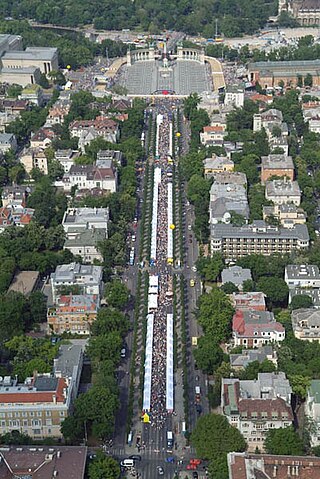
Ferenc Hopp Museum of Asiatic Arts is an art museum in Budapest, Hungary.

Ferenc Hopp Museum of Asiatic Arts is an art museum in Budapest, Hungary.
47°30′41″N19°04′23″E / 47.5114°N 19.0730°E

Kiskörút or Small Boulevard is a major thoroughfare in Budapest. It forms an incomplete semicircle between Deák Square and Fővám Square. It is the border of the southern part of District 5, the innermost district of Pest. As opposed to Nagykörút, it only touches the Danube at its southern end.

Lipótváros is a traditional neighbourhood in the city centre of Budapest, named after King Leopold II. It is one of the two neighbourhoods of District V, the other one being Inner City (Belváros), which is the old town of Pest. Lipótváros was established in the early 19th century, and became the political and financial centre of Hungary in the early 20th century when the Parliament was built on Kossuth Square. Many ministries followed in the later decades. After the 1989 change Lipótváros gradually became again the business centre of Budapest with many banks and office buildings. The neighbourhood is rich in listed historic buildings and landmarks.

Liberty Bridge or Freedom Bridge in Budapest, Hungary, connects Buda and Pest across the River Danube. It is the third southernmost public road bridge in Budapest, located at the southern end of the City Centre. It was originally named Ferenc József híd (Franz Joseph Bridge).

Andrássy Avenue is a boulevard in Budapest, Hungary, dating back to 1872. It links Erzsébet Square with the Városliget. Lined with spectacular Neo-renaissance mansions and townhouses featuring fine facades and interiors, it was recognised as a World Heritage Site in 2002. It is also one of Budapest's main shopping streets, with fine cafes, restaurants, theatres, embassies and luxury boutiques. Among the most noticeable buildings are the State Opera House, the former Ballet School, the Zoltán Kodály Memorial Museum and Archives, the Hungarian University of Fine Arts, and the Ferenc Hopp Museum of East Asian Arts.

The National Széchényi Library (OSZK) is a library in Budapest, Hungary, located in Buda Castle. It is one of two Hungarian national libraries, the other being University of Debrecen Library.

The Deák Ferenc square, named for Ferenc Deák, is a major intersection and transport junction in Budapest. Károly körút, Bajcsy-Zsilinszky út, Király utca, Deák Ferenc utca, and Harmincad utca converge here. Three lines of the Budapest Metro each converge on the station under the square.

The Franz Liszt Academy of Music is a music university and a concert hall in Budapest, Hungary, founded on November 14, 1875. It is home to the Liszt Collection, which features several valuable books and manuscripts donated by Franz Liszt upon his death, and the AVISO studio, a collaboration between the governments of Hungary and Japan to provide sound recording equipment and training for students. The Franz Liszt Academy of Music was founded by Franz Liszt himself.

The Museum of Applied Arts is a museum in Budapest, Hungary. It is the third-oldest applied arts museum in the world.

The Hungarian National Museum was founded in 1802 and is the national museum for the history, art, and archaeology of Hungary, including areas not within Hungary's modern borders, such as Transylvania; it is separate to the collection of international art in the Hungarian National Gallery. The museum is in Budapest VIII in a Neoclassical building, purpose-built during 1837–47 by the architect Mihály Pollack.
Walter "Chico" Hopps was an American museum director, gallerist, and curator of contemporary art. Hopps helped bring Los Angeles post-war artists to prominence during the 1960s, and later went on to redefine practices of curatorial installation internationally. He is known for contributing decisively to “the emergence of the museum as a place to show new art.”

The Ferus Gallery was a contemporary art gallery which operated from 1957 to 1966. In 1957, the gallery was located at 736-A North La Cienega Boulevard, Los Angeles in the U.S. state of California. In 1958, it was relocated across the street to 723 North La Cienega Boulevard where it remained until its closing in 1966.

The Stalin Monument was a statue of Joseph Stalin in Budapest, Hungary. Completed in December 1951 as a "gift to Joseph Stalin from the Hungarians on his seventieth birthday", it was torn down on October 23, 1956, by enraged anti-Soviet crowds during Hungary's October Revolution.

Ervin Baktay was an author noted for popularizing Indian culture in Hungary.

The Budapest Hall of Art or Palace of Art,, is a contemporary art museum and a historic building located in Budapest, Hungary.

Nagytétény Palace or Száraz-Rudnyánszky Palace is today the furniture museum of the Museum of Applied Arts in Budapest established in 1949. It is located at 9-11 Kastélypark Street in the 22nd District of Budapest.
Károly Halász was a Hungarian multimedia artist and co-founder of the Hungarian neo-avant-garde artist group Pécs Workshop. His multi-faceted œuvre can be seen as an extension of a constructivist language – which remained central throughout his career – to a wide range of media from video, performance, and installation to painting, sculpture, and graphics, as well as various thematic focuses from the deconstruction of mass media to institutional critique.

The Bauhaus Foundation, Tel Aviv is a private, non-profit museum and research center in Tel Aviv, Israel dedicated to the conservation, study and display of Bauhaus architecture, design, and art. The foundation is located on 21 Bialik Street, adjacent to Bialik House and old Tel Aviv City Hall, in a building designed by Shlomo Gepstein in 1934. It is owned by American billionaire, businessperson, art collector and philanthropist Ronald Lauder. Initial project was led by Daniella Luxembourg.

Zsóka Gelle is a Hungarian Tibetologist, translator, writer, filmmaker and guide.

Zoltán Felvinczi Takács was a Hungarian art historian. His research interests include the paintings of Albrecht Dürer, Oriental art, and art criticism.